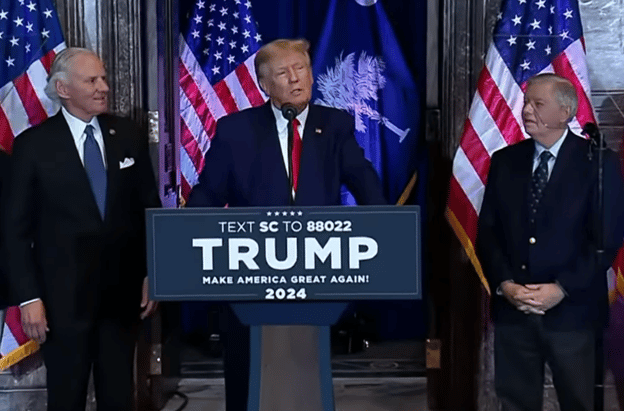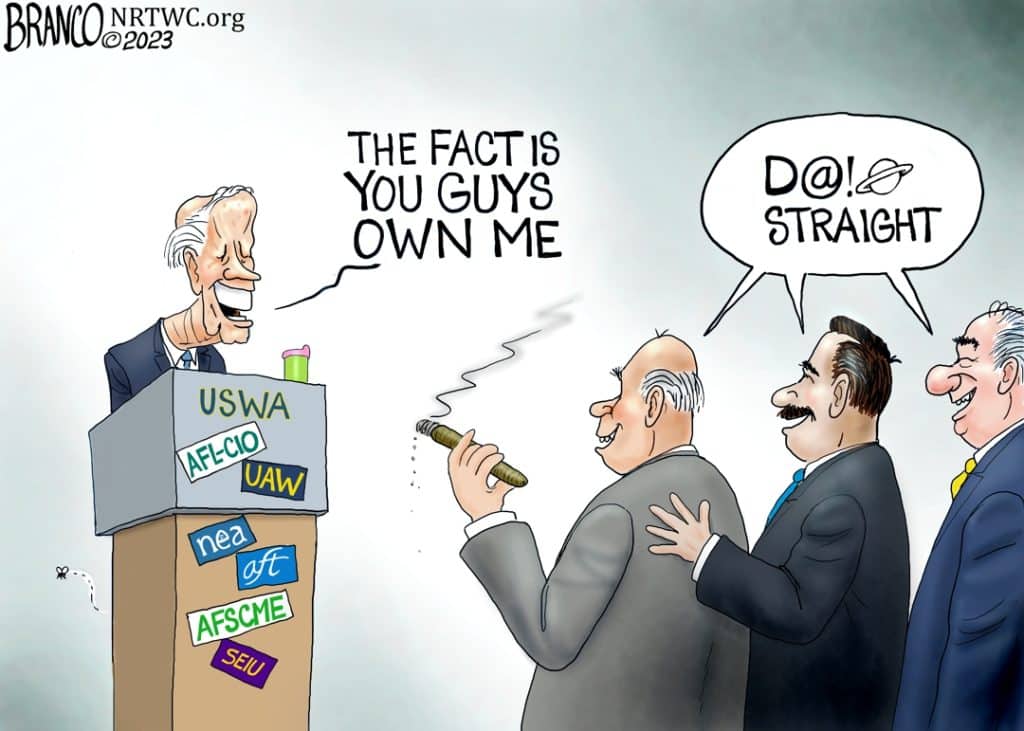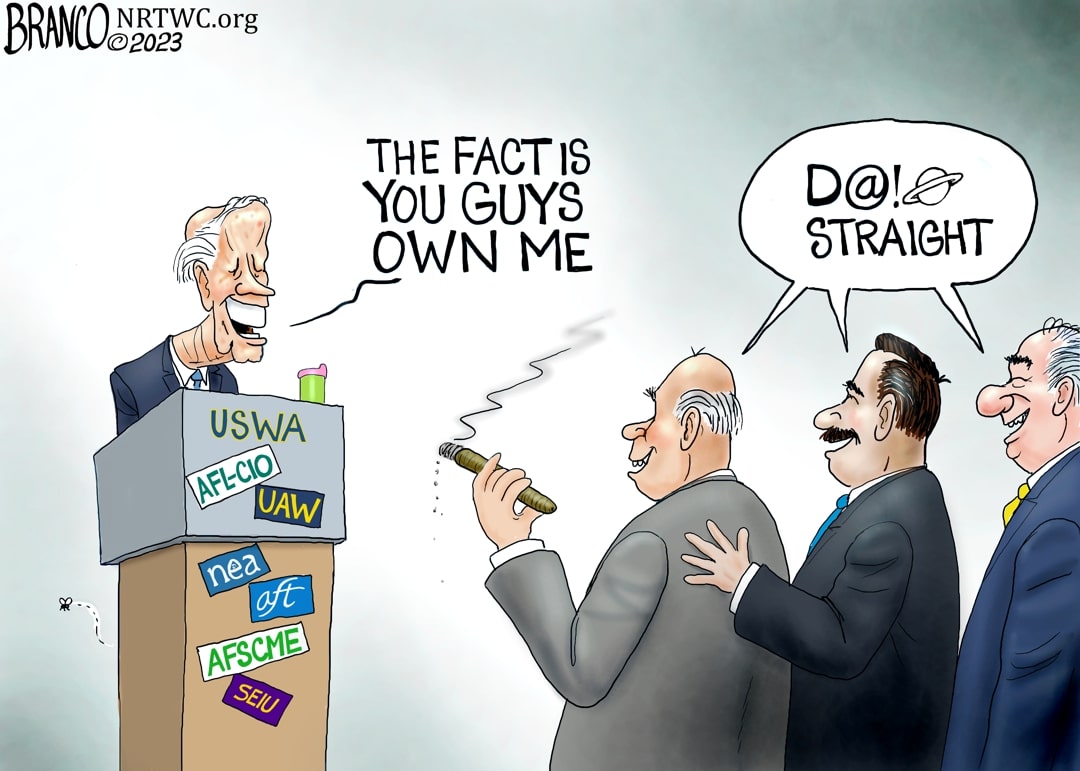Jan. 31, 2023
Permission to republish original opeds and cartoons granted.
Trump in South Carolina warns ‘Joe Biden has brought us to the brink of World War III’ as U.S. and NATO send tanks to Ukraine

By Robert Romano
“Through weakness and incompetence, Joe Biden has brought us to the brink of World War III… We’re at the brink of World War III, just in case anybody doesn’t know it. As president, I will bring back peace through strength.”
That was former President Donald Trump, who is running for president again in 2024, at a campaign stop in South Carolina on Jan. 28, warning the American people that the U.S. and NATO are on the brink of war with Russia, one year after Russia’s invasion of Ukraine, days after President Joe Biden announced that the U.S. would be sending 31 Abrams tanks to Ukraine.
In this case, it is hard to draw much contrast from that assessment to Trump’s opponent in the election, Biden, who on March 11, 2022, in the early days of the war, told members of the House Democratic Caucus that the U.S. would not be going to war any time soon.
Then, Biden ruled out the possibility of sending offensive equipment and tanks, stating, “the idea that we’re going to send in offensive equipment and have planes and tanks and trains with American pilots and American crews just understand no matter what you say, that is called World War III.”
Further warning against military intervention, in March, Biden stipulated, “I’ve moved over 12,000 American forces along the borders with Russia — Latvia, Estonia, Lithuania, Romania, et cetera — because they move once. Granted, if we respond, it is World War Three, but we have a sacred obligation on NATO territory — a sacred obligation — Article 5. And we will not — although we will not fight the third World War in Ukraine. “
What a difference a year makes. Now the tanks are going in. On Jan. 25, Biden made the announcement about the tanks, stating, “I’m announcing that the United States will be sending 31 Abram tanks to Ukraine, the equivalent of one Ukrainian battalion. Secretary Austin has recommended this step because it will enhance the Ukraine’s capacity to defend its territory and achieve its strategic objectives. The Abrams tanks are the most capable tanks in the world. They’re also extremely complex to operate and maintain, so we’re also giving Ukraine the parts and equipment necessary to effectively sustain these tanks on the battlefield. And … we’ll begin to train the Ukrainian troops on these issues of sustainment, logistics, and maintenance as soon as possible.”
But Biden, stated, it will take time to get the tanks into the theater, and so, in the meantime, he has greenlit NATO to go ahead and send their own tanks, too: “I’m grateful to Chancellor Scholz for providing German Leopard 2 tanks and will lead an effort to organize the European contribution of two tank battalions for Ukraine.”
This is escalation, further increasing the likelihood of a highly dangerous direct military exchange between Russia and NATO forces. And it goes against what Biden has previously promised to the American people.
So far, Biden has ruled out the possibility of intervention. Before Russia’s invasion began, even as Biden was correctly warning that the invasion was imminent, on Jan. 25, 2022, one year ago, he told reporters, “We have no intention of putting American forces or NATO forces in Ukraine,” and then when asked again, repeated, “There is not going to be any American forces moving into Ukraine.
The problem is in the same breath, he has also promised victory to Ukraine. In March 2022, even while assuring the American people that the U.S. won’t become a belligerent in the war, he stated, “Putin’s war against Ukraine is never going to be a victory.”
It’s getting to the point where Biden cannot keep both promises.
And so, the U.S. has been promising and delivering to Ukraine hundreds of billions of dollars of military assistance, with Congress’ authorization via blank checks in the National Defense Authorization Act and the recently enacted $1.7 trillion omnibus. It’s hard to argue that the tanks are not authorized when Congress has done everything possible to defer that decision-making to the executive branch, effectively outsourcing its Article I constitutional responsibilities, especially to do with the U.S. nuclear deterrent. Those authorizations are active.
The harsh reality is by the time Congress could convene to vote on, for example, declaring war on Russia, the likelihood is by then the missiles might have already started flying. Just talking about the possibility of a direct war with Russia is potentially provocative. And so is escalating beyond points of no return that the President had previously articulated.
And yet, that is the fine line all presidents in the nuclear age have had to walk.
Various incidents that could very well have sparked war have included the Cuban Missile Crisis in 1962 but also the 1983 near accidental nuclear war that almost occurred when the Soviet Union’s early warning system erroneously reported the U.S. had launched a single warhead at Russia. It turned out, it was a false alarm and was never acted upon.
Given the history and experience with near misses in the nuclear era, Presidents including Harry Truman, Dwight Eisenhower, John Kennedy, Lyndon Johnson, Richard Nixon, Jimmy Carter, Ronald Reagan, George H.W. Bush, Bill Clinton, George W. Bush, Barack Obama, Donald Trump and now Joe Biden have all occasionally spoken about the prospects of nuclear war when they needed to, including frequently invoking the term “Armageddon” itself, sometimes as an imminent danger, as in Cuba and Ukraine, and sometimes as something that seemed far away after Soviet Union had fallen — and, importantly, always as a nightmarish scenario that was best to be avoided by the great powers for the very sake of humanity itself.
Famous among these low-key statements by presidents was that of Truman after the Soviets tested their first weapon in 1949, simply to acknowledge its inevitability: “Ever since atomic energy was first released by man, the eventual development of this new force by other nations was to be expected. This probability has always been taken into account by us… no single nation could in fact have a monopoly of atomic weapons. This recent development emphasizes once again, if indeed such emphasis were needed, the necessity for that truly effective enforceable international control of atomic energy which this Government and the large majority of the members of the United Nations support.”
Harry Truman in his Farewell Address in 1953 said, “Starting an atomic war is totally unthinkable for rational men.”
Dwight Eisenhower in 1953 called for a turn away from the militarization of nuclear capabilities and introduced the “language of atomic warfare”: “I feel impelled to speak today in a language that in a sense is new, one which I, who have spent so much of my life in the military profession, would have preferred never to use. That new language is the language of atomic warfare… In this quest, I know that we must not lack patience. I know that in a world divided, such as ours today, salvation cannot be attained by one dramatic act. I know that many steps will have to be taken over many months before the world can look at itself one day and truly realize that a new climate of mutually peaceful confidence is abroad in the world. But I know, above all else, that we must start to take these steps—now. The United States would seek more than a mere reduction or elimination of atomic materials for military purposes. It is not enough to take this weapon out of the hands of the soldiers. It must be put into the hands of those who will know how to strip its military casing and adapt it to the arts of peace. The United States knows that if the fearful trend of atomic military build-up can be reversed, this greatest of destructive forces can be developed into a great boon, for the benefit of all mankind.”
In 1960, then-Vice President Nixon—who would eventually sign the first Strategic Arms Limitations Treaty (SALT) and the Anti-ballistic Missile Treaty in 1972 (ABM)—on the campaign trail against Kennedy, described the careful language presidents must use when discussing this topic in order to avert war, and spoke of winning the Cold War “without war,” stating, “I am convinced that we do have the strength, and we will develop more, to win this struggle and win it without war. But it is going to take leadership. It is going to take leadership which will be calm in the time of crisis, leadership which will be firm, but leadership which will not be belligerent. Because never must we indulge in the war of words which might heat up the international atmosphere to the point that a nuclear catastrophe would come to the whole world.” Here, Nixon was sagely advising for presidents not to get baited into verbal escalations.
In 1983, Reagan in an interview stated a nuclear war must never occur and called for reciprocal arms reductions by the U.S. and the Soviet Union: “there must not be a nuclear war, then maybe the people will understand why we’re trying so desperately to get a reduction in those weapons worldwide. And I hope that if we start down the reduction road that the other side will see the common sense in eliminating them totally.
In 1984, in a debate with Democratic presidential nominee Walter Mondale, Reagan declared, “A nuclear war cannot be won and must never be fought.”
The war without a war was generally the approach adopted by presidents going forward, with every president from Truman through Trump all averting global catastrophe by acknowledging that there were limits to what American power could achieve as it related to directly challenging other nuclear powers, even while stating the goal was to defeat communism, and instead ushered in an age of nuclear summitry, that for all its flaws and uneven progress, gave the nuclear powers a basis for adjudicating nuclear arms levels and eventually, reducing them for a time.
Begun by Kennedy and Nikita Khrushchev, who pulled missiles out of Turkey and Cuba to avert war, Nixon, who ushered in ABM (terminated by George W. Bush), SALT I and SALT II under Ford and Carter, and capitalized upon by Reagan and Mikhail Gorbachev, who signed the Intermediate Nuclear Forces Treaty (INF) in 1987, and by George H.W. Bush and Barack Obama who signed the Strategic Arms Reduction Treaties (START) in 1991 and 2010, respectively. Of those, the INF Treaty by Reagan and Gorbachev, recently terminated by Trump, was particularly effective at removing nuclear weapons from the continent of Europe in the 1980s, creating so much security it directly ushered in the end of the Cold War.
Now, NATO powers are requesting to once again introduce nuclear weapons to the continent in a bid to deter Russia. The old agreements have been frayed as the old leaders passed on, which predictably has become a pretext for more escalation. We’re in another such arms race today with the advent of hypersonic and other missile delivery systems. In many ways, we’re right back where we started.
Now, the current generation of leaders of the great powers is once again be called upon to either continue that escalation — the last such arms race lasted from 1945 all the way through 1987 — and/or to eventually step back from the brink.
Biden, too, has warned of the potential consequences of a nuclear exchange. On Oct. 6, 2022 at a Democratic Senatorial Campaign Committee fundraiser on Oct. 6, he said, “We have not faced the prospect of Armageddon since Kennedy and the Cuban Missile Crisis. We’ve got a guy I know fairly well; his name is Vladimir Putin. I spent a fair amount of time with him. He is not joking when he talks about the potential use of tactical and nuclear weapons…”
Very clearly, Biden believes the war Ukraine could go nuclear, citing Russian President Vladimir Putin’s threats to use nuclear weapons in the war as Moscow has warned against NATO expansion towards its borders, including Ukraine, which recently applied for fast-track NATO membership after Russia annexed Donetsk, Luhansk and other cities and towns throughout the Donbas region.
The speech also referenced a pursuit of an “off-ramp” indicating a desire for de-escalation in Washington, D.C., stating, “we’re trying to figure out: What — what is Putin’s off-ramp? Where — where does he get off? Where does he find a way out? Where does he find himself in a position that he does not not only lose face, but lose significant power within Russia?”
To the extent that such denuclearization agreements and arrangements have been achieved at all, and to the extent Armageddon has been avoided thus far, it was through reciprocal negotiations that led to occasional breakthroughs.
In October, Biden mentioned “off-ramps” meaning there must be a possibility of a negotiated settlement. And given the alternatives he has already articulated, which seem too terrible to fully contemplate, and his opponent in the election sharing that assessment. When both the President and the former president are saying we’re on the brink of World War III, maybe it’s time to start talking.
Robert Romano is the Vice President of Public Policy at Americans for Limited Government Foundation.
Cartoon: Good Hands
By A.F. Branco

Click here for a higher level resolution version.
To view online: https://dailytorch.com/2023/01/cartoon-good-hands/

Time for Congress to end the Covid emergency
Jan. 30, 2023, Fairfax, Va.—Americans for Limited Government President Rick Manning today issued the following statement urging passage of H.J. Res. 7 and H.R. 382 to both the presidential and Department of Health and Human Services national Covid emergencies:
“This week, the House of Representatives will be voting on two pieces of legislation by U.S. Reps. Paul Gosar and Brett Guthrie to end the 2020 presidential declaration under the National Emergencies Act and by the Department of Health and Human Services for the Covid pandemic. The fact is, the virus is much less deadly than it was in 2020. When the pandemic began, estimated cases peaked in March 2020 at 157,000 per day, and then daily fatalities peaked by April 17 at 2,328 daily, about a 1.47 percent fatality rate, according to IHME. Today, fatalities in the U.S. reached about 645 daily deaths on Jan. 11, out of 1.7 million peak daily new cases from December, a 0.037 percent fatality rate.
“Americans for Limited Government praises House Speaker Kevin McCarthy, House Majority Leader Steve Scalise and U.S. Reps. Paul Gosar and Brett Guthrie for offering legislation that will bring an end to the official Covid emergency, long after the actual emergency has passed. The pandemic is over, and it is time Congress said so.”
To view online: https://getliberty.org/2023/01/time-for-congress-to-end-the-covid-emergency/

